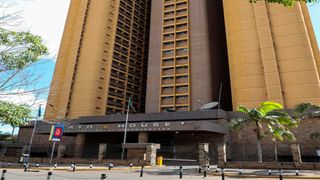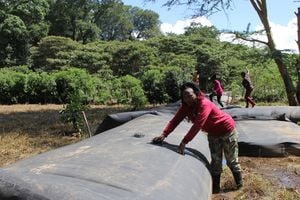
Nyayo House, Nairobi. Interior CS Kithure Kindiki has been compelled by pressure from all corners of society to commit to cracking down on Nyayo House graft cartels.
| Dennis Onsongo | Nation Media GroupNews
Premium
Nyayo House: Kenya’s nightmare that refuses to go away
What you need to know:
- It was revealed that the Kanu regime special security agents converted some of the safe rooms in the building to torture political dissidents.
- Notable victims in the torture chambers included opposition boss Raila Odinga, wa Mwere, former Imenti Central MP Gitobu Imanyara, former Githunguri MP Njehu Gatabaki and journalist Bedan Mbugua.
- Also in the list were George Anyona, the late Wahome Mutahi and legendary benga artiste Ochieng’ Kabaselleh.
It was not the original intention of anyone to name it Nyayo House when its building plan was approved in 1973 by the Ministry of Public works and Ngotho Architects.
The government’s proposed name for it was Nairobi House.
But when its construction commenced in 1979 by the Laxmanbhai constructors—an year after Daniel arap Moi had become the president—at a cost of Sh220 million, his excited handlers figured it out that it was cool if he named it after his political slogan—Nyayo.
It was when Mwai Kibaki became the third president after the 2002 General Election when the secrets of Nyayo House were laid bare—about how it had been transformed by the Moi regime into a horror abode for his political dissents.
The month was February 2003 when the Kibaki administration ordered that the house be open for public visits and the then Nairobi Provincial Commissioner, Cyrus Maina complied.
“Ironically, Nyayoism philosophy that informed the naming of the building had three pillars—peace, love and unity—but what became of the new Nyayo house was not even closer to violence, hatred and disintegration. It was madness,” says former assistant minister Koigi wa Mwere.

From left: Paul Amina, Florence Murage and Wachira Waheire at Nyayo House on May 18, 2023. They are victims of the Moi-era torture.
Mr wa Mwere said that when the building was completed in 1983, “the five year old Nyayo regime had faced an attempted coup in 1982 and to prove to its enemies that it was well grounded and wouldn’t entertain a repeat of such, decided to use arbitrary arrests, torture and detentions without trial as its exclusive coffee to serve.”
The structure house has two wings — North Wing and South Wing — and is 84 metres high with 27 floors standing Standing at the junction of Nairobi’s Uhuru Highway and Kenyatta Avenue.
It was revealed that the Kanu regime special security agents converted some of the safe rooms in the building to torture political dissidents.
Architect Gideon Mulyungi had in 2003 revealed that the rooms that were initially designed to store cash and sensitive classified government documents were the ones that the rogue security agents converted into torture chambers.
The Truth, Justice and Reconciliation Commission (TJRC) that the Kibaki regime had set up had listened to victims’ torture ordeals in the house and ordered for its secrets be made public.
It was when the secret doors were thrown wide open that Kenyans came to learn of 12 impregnable secret cubicles measuring about two-and-a-half metres long and two metres wide built with reinforced concrete to make them fire and sound proof.
Notable victims in the torture chambers included opposition boss Raila Odinga, wa Mwere, former Imenti Central MP Gitobu Imanyara, former Githunguri MP Njehu Gatabaki and journalist Bedan Mbugua. Also in the list were George Anyona, the late Wahome Mutahi and legendary benga artiste Ochieng’ Kabaselleh.
In the book “we lived to tell the Nyayo house story” authored by the citizens for justice, they state that “Nyayo torture chambers were meticulously planned and built using public funds of course specifically for purposes of torturing and killing Kenyans who were deemed to be enemies of the Kanu regime”.
The book adds that “the ultimate objective was to crush the culture and spirit of resistance to the Moi dictatorship that was behaving as if Kenya and its people, as well as resources, were private property of the ruling elite”.
After the 1982 crackdown of characters the Moi regime suspected of plotting its ouster through violence, it again commenced a crackdown in 1986 on a group of people referred to as Mwakenya activists.
“The public was told that this was a group of very dangerous individuals who were planning to wage a guerrilla war against the Kanu government,” wa Mwere said.
The revelation saw the government restructure some of the components where the torture chambers have since been converted into a 62 cars’ parking lot.
The bad history about Nyayo House camouflaged the core value in its host to Nairobi County’s National Government Administration Officers (NGAO) as well as being the headquarters of the immigration department.
Owing to the two government institutions, Nyayo House is among the busiest in the capital.
As if bad memories are contagious, the Nyayo House has found it hard to shed off its nightmarish relations with the citizens, continuing to be a nightmare to Kenyans who have incessantly complained of deeply rooted corruption in the way government services are procured from officers based there.
Interior Cabinet Secretary Prof Kithure Kindiki has been compelled by the pressure from all angles, including from the National Assembly to commit himself to cracking down and cleaning up the mess.
While he appeared before the Regional Integration Committee on Thursday at the Parliament Buildings, Kindiki acknowledged being in the know of the corruption network that has gripped the nerve centre of how international community merge and behave in Kenya.
He admitted that there is corruption in the immigration offices and was also aware that there are officials who have made it a culture to play monkey business in the way the crucial passport document is processed.
He said that the corrupt network ensures bribes are the norm so that services that are supposed to be offered free of charge have been monetized.
So daring are the cartels in the game that they have been advertising their services in the social media where they promise to fast track service at a fee.
"I will clean up Nyayo house once and for all…We will seal off Nyayo house and name it a scene of crime. The corruption there has a direct relation with some of our ongoing problems, such as insecurity and terrorism,” said Prof Kindiki.
Kindiki added that owing to the slowed service delivery to give room to bribes, passport backlog currently stands at 58,000.
Former Nairobi Provincial Commissioner Joseph Kaguthi says “shedding off the image of torture chambers has become hard to shed off and suggests that it be renamed to something more appealing”.
He says “we can try renaming it to Immigration House or Democracy house…Freedom House…such nice names that will help sooth souls walking into it as Kindiki moves in with a broom to get the corrupt elements direct into the dustbin”.
Mr Kaguthi says “while it is okay that some of those who were tortured in the Nyayo House have been compensated, kit is not okay that the blot the infamies inflicted the national soul is yet to be assuaged but it now appears that Kindiki has become alive to that need and ridding the place off corruption is the only way out”.





